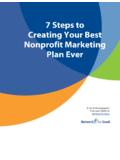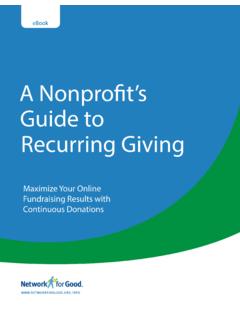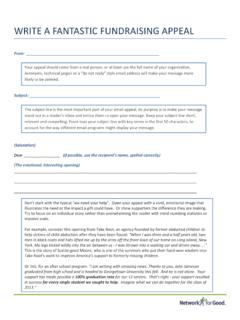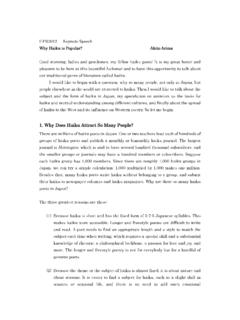Transcription of Storytelling for Nonprofits - Fundraising
1 EBook Storytelling for Nonprofits How to Present Stories That attract Donors, Win Support, and Raise Money /NPO. Storytelling for Nonprofits How to Present Stories That attract Donors, Win Support, and Raise Money Everyone in your organization needs a good story. 3 Elements of a Great Story To intrigue a journalist. To inspire a 5 Get Into Character donor to give. To motivate staff to aim higher. To spark an advocacy revolution. 7 Premium Fuel: Emotion To land a corporate sponsorship deal. 10 Collecting Your Stories Stories are the basic building blocks for 11 Why Bad Stories Happen to reaching our goals. Good Causes As fundraisers, it's not enough to arouse sympathetic emotions. We need to 13 Create a Sense of Urgency motivate people to act on those emotions, to vote with their checkbooks.
2 We need to 14 The Power of the Picture overcome the painful feelings that come with acknowledging the presence of 15 Tell Your Story with Visuals suffering in our world. Research shows that this is all possible, though it's not 17 Five Reasons to Tell Your Story always easy. The most powerful tool in a on Social Media .. fundraiser's bag is to tell a great story. 18 .. And How to Do it Strategic Storytelling can be done. Let's start doing it together! 19 Stories in Action 21 Get Going 22 Storytelling Checklist 23 About Network for Good 24 Sources /NPO 2. Elements of a Great Story Storytelling is the single most powerful communications tool you have available, bar none. But many good causes tend to have problems telling good stories even though people have been communicating through stories for thousands of years.
3 So, what makes narrative so powerful? 1. Stories help us remember. When you have facts you want people to remember, it's much more likely they will be remembered if you contain those facts within a story. 2. Stories influence how we decide. In 1990 a study was done on how people on juries came to conclusions. According to the study, most construct a story based on the facts offered in the case. Then they compared the stories they constructed with the stories the lawyers presented. The jurist would side with whomever's story matched their own the closest. 3. Stories link us to our sense of generosity. Studies also show that donors tend to give twice as much when presented with a story about an affected individual as opposed to reading huge abstract numbers of the overall scope of a problem.
4 Hopefully, you realize your organization should be telling stories. Stories make a cause relatable, tangible, and touching. So how do you write one? What is the structure of a well- told story? Screenwriting guru Michael Hauge boils all great stories down to three elements: 1. Character Character is our protagonist. Hollywood can make us feel empathy for such unlikely protagonists as fish (Nemo) and aliens (Avatar). But how do they do it? Roughly 99% of the time, the protagonist of a good story is a single individual. Try not to focus on an idea or an organization, but on one relatable character (or The Lampion Center creates an a personified entity, as Shel Silverstein did in The emotional appeal with an Giving Tree).
5 A team led by Deborah Small of the unlikely character: Roary University of Pennsylvania found that people are the Lion. Donors can send a stuffed-animal version of the twice as likely to give a charitable gift when presented mascot to sick children. with an emotion-inducing personal story that focuses exclusively on one character's plight. Credit: /NPO 3. 2. Desire Desire doesn't necessarily mean lust or greed; it can also lead to a burning need to change the character's world: to obtain something, get rid of something, restore order, or escape a threat. Don't forget about desire when writing your story. While character and conflict are definitely important, they can't shine without their third musketeer.
6 As fantasy writer Mark O'Bannon writes, Desire must be clear, specific, and definite.. 3. Conflict Conflict simply refers to the obstacles that arise and prevent the character from getting whatever he or she wants. Conflict is a story's oxygen; the more conflict, the more engaging the story. Powerful stories are about suffering and hardship. Readers respond best to conflict they can identify with, but that doesn't mean your readers need experience living in a war zone. They just need to be able to relate to pain, illness, or loss. Don't be afraid to talk about conflict! Many organizations don't like to name their villains or show true conflict. They're afraid to unleash powerful emotions. But if organizations succeed in sanitizing their stories, scrubbing them of all conflict, emotion will fly out To make sure you cover all of the basics of story structure here are the beginnings of six sentences that can help you with the process.
7 1. Once upon a time .. This starts the story off and introduces our protagonist. 2. And every day .. This will set up how life was before the challenge or inciting incident. 3. Until one day .. This begins the action of the story with the challenge and the goal. 4. And because of this .. This introduces the barriers or obstacles the protagonist faces. 5. And because of this .. There could be several barriers that need introduction. 6. Until This ends the story with the resolution. /NPO 4. Get Into Character It's becoming much easier to tell your story of the clients you serve especially if you have a smartphone, a social media presence, and a few juicy questions to ask. Unfortunately, it can be more difficult to tell a story with which your donors can identify.
8 Here are 12 questions to help you get into character and reinforce the emotional connection of your story. Think, As the donor .. 1. Do I Belong Here? That's the first question in the mind of every donor. One way or another, they must locate themselves in your story. They must experience a genuine emotional pull that says what you do matters to them, personally. It might be the cause itself, a pet project, their relationship to a staff person the possible intersections are endless. It's your job to help connect the dots and determine why people generally get involved. Additional Questions: Can you describe who most easily identifies with your work? What are you doing to remind them of how they belong with you?
9 How might you give them something to remember you for? There are many reasons people are motivated to donate, but the constant is always meaning. That is your true currency and the building block of all great stories. How can you create a pride of belonging? 2. What Do You Stand For? More than just numbers, donors invest in organizations that reflect their own personal values and worldview. In giving to a specific group, they are expressing themselves through the work that you do. Their image of self is bundled with how they direct their giving. When they give to your organization, that's a reflection of who they are or who they aspire to be. So how are you reinforcing their story of identity?
10 Additional Questions: How do you communicate the philosophy of your organization? Does your ethos speak to a narrower or mainstream audience? What might you do to evolve your story for greater relevance? As the saying goes, The most important things are choosing what's most important.. That's why you need to clearly articulate your values, and in a manner that hopefully is generative for attracting more people into the mix. /NPO 5. 3. Are You For Real? There are plenty of worthy causes. Yet increasingly donors question what organizations are worthy of contribution. People more and more question where there money is going, and whether they're making the right choices. Being for real requires that you demonstrate your authenticity and legitimacy.

















